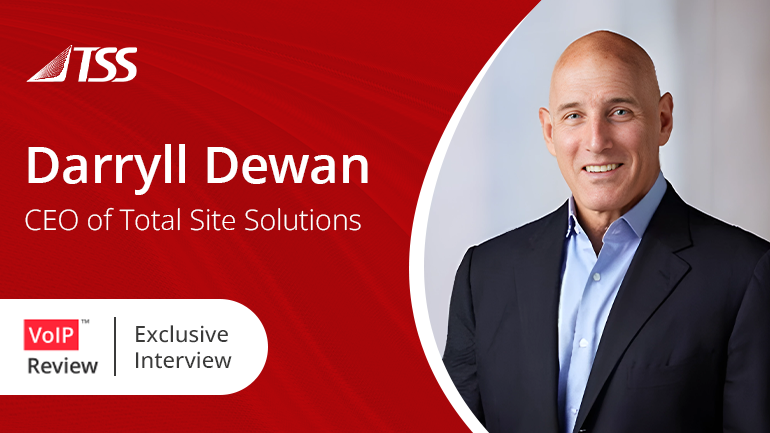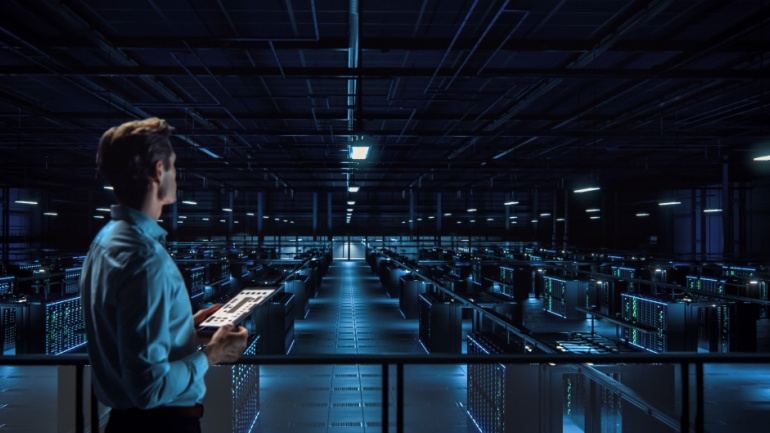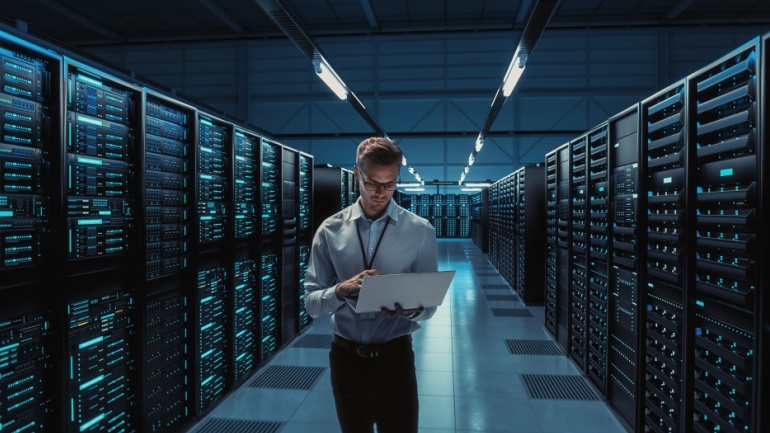“In the world of IT, nothing is static.”
These words from Darryll Dewan, CEO of Total Site Solutions (TSS), encapsulate the dynamic nature of the data center landscape in 2024.
The Data Center Technology Trends report by TSS uncovers the latest shifts happening in data centers in 2024. Darryll Dewan with his extensive experience in data security and IT infrastructure, offers invaluable insights into how these trends are shaping the industry and impacting businesses.
In this interview, Mr. Dewan dives into the four key trends highlighted in the TSS report:
- The rise of modular data centers (MDCs) and their potential to revolutionize deployment.
- The ever-increasing importance of data center security and compliance.
- The growing emphasis on sustainability and energy-efficient data center solutions.
- The widening skills gap in the data center workforce and strategies to bridge it.
The Data Center Technology Trends report outlines several key trends impacting the data center industry in 2024. Can you walk us through the most significant trends you see shaping the data center landscape this year and how they are impacting your company’s strategy?
2023 was an extremely pivotal year in the data center technology industry driven by the explosive growth in advanced computing technologies and generative AI solutions. Looking ahead to 2024, there are four trends that we at TSS see continuing to shape the landscape – almost all driven by the use of AI and more powerful technology. The first is the growth and interest in modular data centers. The offerings of an MDC serve as an alternative to expanding existing enterprise data centers. MDCs mean more (digital) room in less (physical) space. This, paired with their flexibility to deliver high-performance computing technology, with a faster deployment, and at a lower cost makes them difficult to beat as an enterprise data center option. MDCs can be a more sustainable option both for their environmentally friendly design and as they reduce maintenance costs and challenges from more advanced thermal management.
Our second trend for 2024 is continued emphasis on security and compliance. In this digital age, data is important, and protecting said data is increasingly crucial. We can’t stress enough the importance of partnering with vendors that prioritize security and take extra steps to safeguard your networks and physical infrastructure.
The third trend is the increased emphasis on protecting and sustaining the environment. This is driving the adoption of more advanced cooling methods (like direct liquid cooling), energy-efficient hardware, materials, and designs that reduce the overall carbon footprint. Liquid cooling is fast moving from a trend to a must-have in the deployment of high-performance computing infrastructure.
The fourth trend we are observing is a continued skills gap and an increase in training. Enterprises are struggling to find talent that is versed in the needs of AI, the growing complexity of systems, and the deployment of environmentally friendly and sustainable technologies. This means enterprises, vendors, and educational institutions and organizations partnering to provide the essential training needed to provide qualified professionals to integrate, deploy, and maintain the infrastructure. In the world of IT, nothing is static.
Staying on top of these trends will help IT professionals make better use of resources and better planning decisions for the future.
Modular data centers (MDCs) are gaining traction. What are your views on their potential to revolutionize data center deployment? Are there any limitations to consider when implementing MDCs?
Modular Data Centers (MDCs) are an effective alternative to expanding enterprise data centers. MDCs are designed for rapid deployment, energy efficiency, and high-density computing. They are prefabricated units that can be custom engineered, quickly shipped, and assembled on-site, encompassing advanced technology, including racks, cooling systems, power units, and security devices. MDCs have been quality tested and validated before shipment, ensuring quality, reliability, and the ability to use the technology more rapidly and efficiently. In addition, MDCs can be deployed in a variety of environments from urban to remote, delivering high-computing power to traditional underserved environments.
Modular data centers offer greater flexibility in deployment and technology adoption, ensuring better planning and investment. For instance, with the rush to AI, organizations do not know their full capacity needs. MDCs allow them to move quickly to satisfy today’s needs and the ability to add or adjust in the future. They can be easily reconfigured or relocated to meet changing business needs or to incorporate the latest technologies. Their design supports customization and is conducive to experimenting with new data center configurations, cooling technologies, or energy sources.
Modular Data Centers often have lower upfront investment than traditional data center deployments. The prefabricated nature of these modules means they are manufactured in a controlled environment, reducing construction and labor costs. The efficient design of an MDC can lead to substantial savings in power and cooling expenses over time. In addition, companies can pay for space/capacity as needed or as IT equipment is received, resulting in a more effective use of capital.
Another advantage of MDCs is their energy-efficient design. Advanced cooling techniques, such as liquid cooling and efficient power usage, make them environmentally friendly and appealing to organizations looking to reduce their carbon footprint and achieve sustainability goals.
Cyberattacks are a constant threat. How is your company staying ahead of the curve and helping customers in terms of data center security, especially considering the growing focus on compliance?
At TSS, we have recently expanded our service offering to provide our vendor partners and end-user customers with our ‘cybersecurity in a box’ solution. The TSS Cybersecurity solution integrates, configures, and delivers cybersecurity server, storage and cyber senor technology solutions to a customer’s high-performance computing and IT infrastructure to better protect their systems and data from the ever-evolving threat of security breaches. These integration solutions call on our decades of experience and expertise to protect some of the world’s largest and most powerful systems, protecting both the infrastructure and data, including cyber recovery integration services.
While we don’t publicly detail our security practices and infrastructure, TSS employs state-of-the-art security protocols from the implementation of multi-factor authentication, biometric access controls, and round-the-clock surveillance to continuous monitoring of threats and we adapt defenses accordingly. We stay informed about evolving compliance regulations and our facilities and infrastructure adhere to industry standards such as GDPR, HIPAA, and ISO 27001. We have regular audits to validate our compliance practices, ensuring that infrastructure and data remains secure. Our commitment to data center security extends beyond technology—it’s ingrained in our culture.
Data security regulations are becoming stricter. How can companies ensure that their data centers comply with these evolving regulations, and how does this factor into decision-making when choosing technologies and strategies?
As data security regulations tighten, companies must proactively adapt to ensure compliance within their high-performance computing and IT systems and infrastructure. From a hardware perspective, there are several key steps companies should undertake, beginning with a thorough risk assessment reviewing both the technical and human elements of data security and compliance. This assessment should fully consider the specific regulatory requirements of the industry they are in or that they serve, and the regional differences should they operate globally or across regions.
The core concepts of data encryption and masking, regular audits and monitoring, patch management and vulnerability remediations, and data classification and segmentation are basic blocking and tackling for all modern enterprise compute and IT system infrastructure.
One of the final pieces of the compliance puzzle is ensuring your company has thoroughly evaluated third-party vendors that are providing, integrating, and configuring your IT and data infrastructure – not just in their facilities, but through the entire supply chain, logistics, and deployment process.
Can you elaborate on the specific green initiatives your company is undertaking to make data centers more energy-efficient and environmentally friendly?
We are ahead of most companies in our ability to integrate, test, deploy, and manage liquid cooling systems in the high-performance computing environment. Our experience and expertise have allowed us to design and deliver these solutions to some of the largest data companies in the world and we’re seeing demand continue to grow.
We also work closely with our OEM partners and customers to support their initiatives, ensuring we use recycled materials for packaging and shipping, including reclamation of wooden skids, reuse of shipping crates, and recycling of the majority of materials that come through our state-of-the-art integration center. We’ve invested in upgrading our own power and cooling technologies to be better stewards of resources and the environment and look for additional ways to support our partners and customers in their efforts.
The report identifies a growing skills gap in the data center workforce. What steps should companies take to bridge this gap and ensure teams have the expertise needed to manage these evolving technologies?
The rapidity of the change in high-performance computing technology, power and cooling technologies and the adoption of generative AI has more rapidly created a larger skills gap in the data center workforce than ever before. To bridge this gap, collaboration between industry leaders (vendors and customers), educational institutions, and business associations can lead to the timely development of curricula and training to address the evolving needs of the sector.
In our post-pandemic world, we can leverage online learning and video to provide planned and real-time education and training to people in the field. Companies must invest in continuous training, certification and mentorship programs to update and validate their expertise in the latest technologies and meet the market’s needs.
Traditionally, CIOs oversaw data center needs. Now, CEOs and CFOs are involved. Why do you think this shift is happening, and how is your company adapting its leadership approach to this new dynamic?
The pressure facing many companies to deploy AI based solutions involves senior management and board-level scrutiny to deploy faster and cost effectively. Companies must address and deal with infrastructure challenges, supply chain constraints, and the cost to a company following a technological disruption has never been more important to their ability to operate and remain competitive.
TSS is at the intersection of advanced computer technology and AI and integrates solutions with quality and speed. We are now actively helping our vendor partners and end-user consumers of the technology make better decisions on the design, integration, deployment, and maintenance of their infrastructure. We’re helping eliminate their challenges with the skills gap by providing talent and expertise in our integration center and in our customer facilities as well. This helps fill the skills gap.
How are the data center trends discussed in the ‘Data Center Technology Trends’ report impacting your clients’ needs and expectations? Are there specific ways your company is tailoring its solutions to address these evolving needs?
We are becoming embedded in our clients’ operations, and they are engaged with us virtually every day and at every step of the process. These trends can have a significant impact on time-to-value, so working together on every step of the design, integration, and deployment process enables the end-user to consume and benefit from the technology more rapidly. Our MDC-related services are a great example of that, as we have delivered more than 500 MDCs in the past several months.
We have launched new services in areas where we have seen gaps in the process like cybersecurity, upgrades to existing technologies, data center moves and maintenance, and meeting the demand for integration and testing of direct liquid cooling.
Looking ahead, what are your predictions for the biggest trends that will shape the data center technology landscape in the next few years?
We and others believe the demand for advanced computer capacity and infrastructure solutions will continue to drive the industry. Data center capacity is being purchased as fast, if not faster than it can be constructed.
The availability of power will continue to be a challenge. This will continue to drive innovation and challenge the best of us to adapt to change and move faster. As this technology gets more powerful and AI more prevalent, having the power to drive that capacity and the ability to cool technologies that are becoming increasingly dense in sustainable ways will continue to be a need and challenge. We believe we will see the adoption of more microgrids that can offer cheaper, cleaner, and more resilient power and that data center providers can utilize to add to and support the electrical grid rather than simply consume power. There will be work done in public policy and public education that will lead the way to more small nuclear reactors (SMRs) that can safely provide exceptional power supplies in both rural and urban areas. Similarly, innovative new cooling technologies will be delivered that not only solve the heat challenges but do it in a cost-effective, climate-friendly way.
We are only starting to see what the innovative minds in our industry will do to meet the challenges. We’ll see technologies in the next couple of years that were not even dreamed about just five years ago. With AI machine learning combined with human ingenuity, the need for data management and computing power and infrastructure has never been greater – until tomorrow and the day after. TSS is excited to be at the intersection of all these things coming together to power our daily lives.







